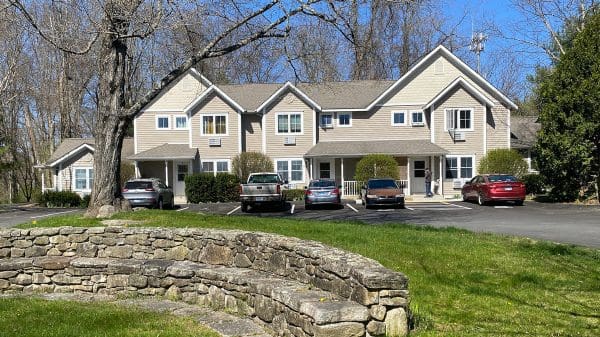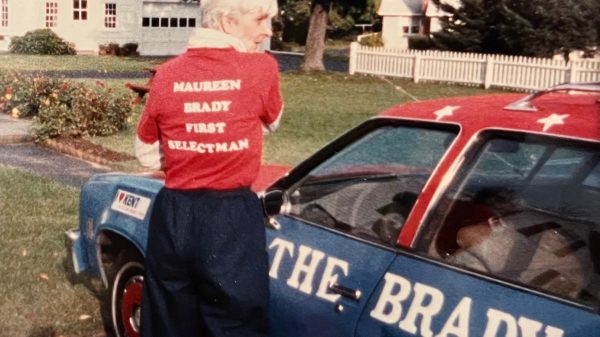KENT—The Inland Wetlands Commission will seek additional data on plans to replace a crumbling bridge spanning Cobble Brook at 99B Cobble Rd. as quickly as possible and will then call a special meeting to act on the proposal.
Steven Abbate appeared before the commission Feb. 26 with an altered proposal for the bridge’s replacement after the owner of record, the Northwest Connecticut Land Conservancy, refused permission to stockpile material on its property during construction and to remove trees from its land. The NCLC had initially given permission and later withdrew it.
Abbate’s property is landlocked except for a 50-foot right of way across the brook to Cobble Road. The bridge, which passes over a culvert, is in danger of collapse because the culvert pipe is rotted out.
Michael Gawel, owner of Gawel & Sons Construction, explained that beavers dammed the uphill end of the pipe and that the pressure folded the ends inward. “The pipe was put in 1985-ish and is at the end of its lifespan,” he said, adding that with the narrowed opening, “every time there is a heavy rain, it floods and washes out around it.”
The application is further complicated by a question of whether the Department of Energy and Environmental Protection should be involved in the bridge construction.
Land Use Officer Tai Kern said town counsel advised that the IWC could make its decision irrespective of DEEP and “leave it to the property owners whether to go forward.”
She noted that the application was significantly altered only that afternoon, but that the IWC’s timeframe for making a determination ended with its meeting. Chairman Lynn Werner was reluctant to act on a proposal that had been changed without time for review.
“Do we have enough time to understand what this new application is?” she asked. “My concern is, we’re being rushed into a decision tonight. It feels to me like I haven’t had enough time to fully absorb the letter and the changes.”
Kern said the previous proposal was drawn up by a civil engineer, but the revision was made by a structural engineer. The applicants argued that no changes were being made to the construction of the bridge itself as previously proposed.
Abbate said the last-minute changes were made because he had only received the NCLC’s withdrawal of permission on Feb. 23. He stressed the urgency to act on the replacement and said the plan submitted Monday was simpler than the previous proposal.
“Only Friday did we receive a letter from the land trust that withdrew its approval for some aspects of the job,” he said. “We would have had to sign licensing agreements, agree to fines and penalties, etc. So, we’re not going to go on their property; we’re not going to cut trees, and we moved the stockpiling to my right of way. We’re not going to put boulders in the riverbed because that would go beyond the 50-foot right of way and because the commission didn’t like that idea the last time we appeared. We just took three things away and are doing everything else within the right of way.”
The current bridge is in such poor condition that emergency vehicles cannot reach his house. The residents have instructed the propane delivery company to bring only light loads. Efforts were made to reinforce the existing bridge but, with spring coming on, it is beginning to collapse again, Abbate said.
Gawel argued that the new proposal brings “far less intrusion into the regulated area.”
“It’s simpler than it was. I don’t see why we should need a civil engineer. The only time the stream will be touched is when we pull the pipe out—and that is quick. Everything will be stable before we pull the pipe out.”
Kern said a civil engineer would provide different information than a structural engineer.
Werner feared that returning the streambed to its original 14-foot width would cause siltation below the bridge to be disturbed. She stressed she would like more time to consider the application and that a civil engineer should look at the plan. “I just don’t want any unintended consequences,” she said, adding she hadn’t found the original plan “sufficient.”
“I’m just scratching my head and thinking we gave you everything you asked for and gave you a simpler plan,” said Abbate. “We have to bring in 60 tons of material every time it washes out. This thing is completely rusted out and rotted on the bottom and it puts my family in danger.”
Other members of the commission felt the safety factor outweighed any lingering doubts. Member Anthony Palumbo said he found the situation “a little scary,” while Marge Smith said, “Yes, silt will move around a little bit if the stream goes back to its original width, but this is a vast improvement over a five-foot-wide pipe. Safety is a bigger issue.”
A compromise was struck when it was agreed that the town would have its consulting civil engineer look at the proposal as quickly as possible and that a special meeting would be called to act within 24 hours after that report is in hand. Abbate will pay for the review.
“I feel there is an urgency here,” said Palumbo. “It seems like there’s not much impact to the stream and the urgency outweighs other circumstances.”
In other business, an application from Karen Pittelman to remove invasives along Cobble Brook was withdrawn temporarily and John Slowik, who has drainage problems at 111 Geer Mountain Rd., asked to have his application tabled until more information is available.
Albert Loverro appeared before the commission to present his application to removed invasives and dead or dying trees from his property at 310 Kent Cornwall Road but was told that he had to file a more complete application. His neighboring property owners also appeared, saying they were unhappy with previous alterations to his land that they asserted diverted runoff to their own properties.
The commission decided that a physical review of the site is in order, but Werner advised the neighbors that the commission is “not an arbiter” of property surveys.




























